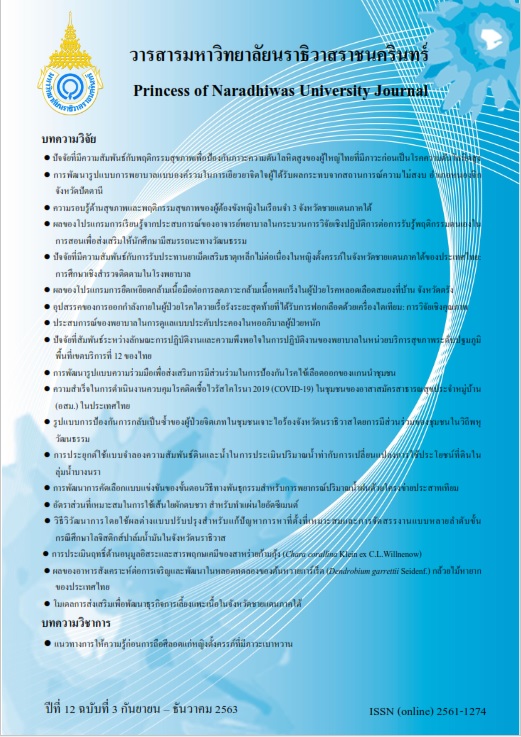The Extension Model for Business Development of Meat Goat Production in Southern Border Provinces
Keywords:
Extension model, Meat goat, Business for meat goat farming, Southern border provincesAbstract
This research aimed to develop and present an extension model for business development of meat goat production in the southern border provinces. Mixed methods were used as a research methodology. The quantitative data were collected from participants living in the southern border provinces: 1) 365 farmers who raise meat goats, 2) 100 persons of goat meat consumers 3) 40 restaurants selling goat meat and 4) 50 goat dealers. The sample derived from purposive sampling technique. Data were collected through interview with structured questionnaire and analyzed by descriptive and relationship statistics. The qualitative data were collected from 25 government officials, who promote raising meat goats in the southern border provinces, conducted through interview with structured questionnaire and group seminars. The data were analyzed using descriptive statistics; frequency, percentage, mean, standard deviation, and SWOT analysis.
The results showed that 1) most farmers were males with average age of 49.02 years old and completed primary school education. The average household income was 82,791.79 baht per year which earned from meat goat farming 14,009.80 baht per year, 2) the meat goat farming was mostly small farmers, and they do the farming as a part-time job. The meat goats were for household consumption and used for religious rituals, 3) there were needs of knowledge for the development of meat goat farming and production from the officials of livestock department and successful private farms, shown in total 24 aspects. It could be doing workshop or participating in observational study. The farmers also expected to receive other supports from the officials of livestock department, 4) the development of business model included the Supply chain system, the Marketing mix or 4 P’s and the Communication principles (SMCR and 5) the suitable model for development of meat goat business was to focus on passing on the knowledge to farmers through communication which involved the sender (the officials from livestock department), the message (knowledge provided), the communication channel (workshop and observational study including setting up farmers’ market group) and the receiver (goat meat farmers who received knowledge for further business development)
References
Berlo, D., K. (1960) The process of communication. New York, New York: Holt. Rinehart. & Winston Information and Communication Technology Center. (2017). Data Meat Goat of Thailand 2017. Department of Livestock Development.
Boonyathithan, E. (2011). Professional SWOT Analysis Manual. Bangkok Payychon. Thailand.
Department of Livestock Information. (2017). Statistics Number of livestock. Department of Livestock. Ministry of Agriculture and Cooperatives.
Department of Livestock Information. (2013). Statistics Number of livestock. Department of Livestock, Ministry of Agriculture and Cooperatives.
Kochapakdee, S. (2006). Treatise for raising meat goat. Faculty of Technology Community Development, Thaksin University, Phatthalung Campus.
Limcharoen, S., Khongsen, M., Taahai, S. & Peeyao, M. (2018) Effects of Laveamisol Ivermectin and Albendazole on eradication ofgastro - intestinal parasite in goats (Capra hircus). Khon Kaen Agr. J. 46 suppl. 1: (2018), 622-627.
Limcharoen, S., Khongsen, M., Thepkun P., Jun-iad, J, & Duerraoo, H. (2019). A Promotion Guideline of Goat Meat Consumption in Narathiwat Province. Khon Kaen Agr. J. 47 suppl.1 : (2019), 999-1888.
Limcharoen, S., Laleng, M, Mat, M., & Laten, B. (2016). A Study on Meat Goat Raising of Farmers in Mueng District, Narathiwat Province. National Academic Conference 4 Princess of Naradhiwas University. (2016), 61-71.
Prabu, M., Selvakumar, K., N., Pandian, A. S. S., Kumar, G. S. & Meganathan, N. (2011). Profitability Analysis of Goat Farming in Tamil Nadu. Indian Journal Animal Research. 45(1).
Pralomkarn, W., Supakorn, C., & Boonsanit, D. (2012). Knowledge in Goats in Thailand.Walailak. Journal Science & Technology, 9 (2), 93-105.
Office of Agricultural Economics. (2019) Data Basic agricultural information 2019 Retrieved December 6, 2019 from http:// http://www.oae.go.th/.
Si Sa-at, B. (2002). Statistical methods for research, Volume 7. Bangkok Soviriasss.
Vineebanchar, K. (2012). Using SPSS for Windows in Data Analysis. Department of Statistics, Faculty of Commerce and Accountancy, Chulalongkorn University. Bangkok. (In Thai).




